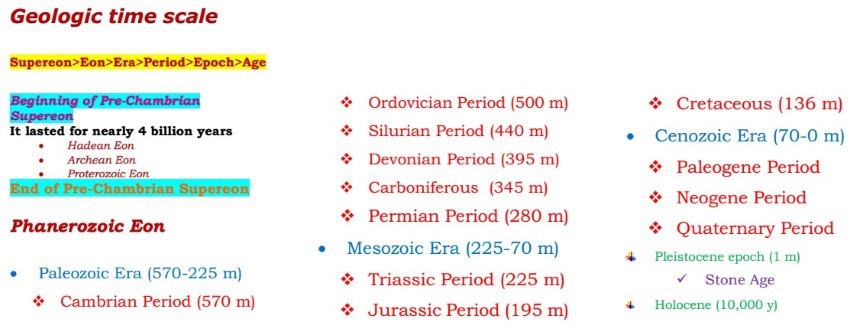Indian Rock System: Archaean, Purana, Dravidian & Aryan Rock System
Table of Contents
Rock System Based on Geological History Of India
- The Archaean Rock System.
- The Purana Rock System.
- The Dravidian Rock System.
- The Aryan Rock System.


Archaean Rock System (Pre-Cambrian Rocks)

- Rocks formed prior to the Cambrian system.
- The Archaean rock system includes:
Archaean Gneisses and Schists [4 Billion Years]
Gneiss == Mineral composition varies from granite to gabbro.
Schists == mostly crystalline, include mica, talc, hornblende, chlorite, etc.
These rocks are:
- Oldest rocks [pre-Cambrian era] [formed about 4 billion years ago].
- Rocks formed due to solidification of molten magma – the earth’s surface was very hot then.
- Known as the ‘Basement Complex’ [They are the oldest and forms the base for new layers]
- Azoic or unfossiliferous,
- Foliated (consisting of thin sheets),
- Thoroughly crystalline (because they are volcanic in origin),
- Plutonic intrusions (volcanic rocks found deep inside).
Dharwar System [4 – 1 Billion Years]
- Formation period ranges from 4 billion years ago to – 1 billion years ago.
- Highly metamorphosed sedimentary rock-system. [formed due to metamorphosis of sediments of Archaean gneisses and schists].
- They are the oldest metamorphosed rocks.
- Found in abundance in the Dharwar district of Karnataka.
- Economically the most important rocks because they possess valuable minerals like high grade iron-ore, manganese, copper, lead, gold, etc.
Purana Rock System (1400 – 600 Million Years)
- Includes two divisions: the Cuddapah System and the Vindhyan System.
Cuddapah System
- Unfossiliferous clay, slates, sandstones and limestones was deposited in synclinal basins [depression between two folds {Fold mountain}].
- Outcrops best observed in Cuddapah district of Andhra Pradesh.
- These rocks contain ores of iron, manganese, copper, cobalt, nickel, etc.
- They contain large deposits of cement grade limestones.
Vindhyan System (1300-600 million years)
- This system derives its name from the great Vindhyan mountains.
- The system comprises of ancient sedimentary rocks (4000 m thick) superimposed on the Archaean base.
- Mostly Unfossiliferous.
- Large area of this belt is covered by the Deccan trap.
- The Vindhayan system have diamond bearing regions from which Panna and Golconda diamonds have been mined.
- It is devoid of metalliferous minerals but provides large quantities of durable stones, ornamental stones, limestone, pure glass making sand etc..
Dravidian Rock System (Palaeozoic)
- Formed about 600 – 300 million years ago.
- Found in the Extra Peninsular region (Himalayas and Ganga plain) and are very rare in Peninsular India. [The name ‘Dravidian’ doesn’t mean they are found in South India]
- Abundant fossils.
- The rocks of Cambrian, Ordovician, Silurian, Devonian and Carboniferous periods are fall under Dravidian system. (All these are not important, only Carboniferous is important)
Carboniferous rocks (350 million years)
- The Carboniferous rocks (350 million years) comprise mainly of limestone, shale and quartzite.
- Mount Everest is composed of Upper Carboniferous limestones.
- Coal formation started in the Carboniferous age.
- Carboniferous in geology means coal bearing. [most of the coal found in India is not of Carboniferous period; High quality coal of Great Lakes Region-USA, U.K and Ruhr region is Carboniferous coal].
Aryan Rock System
- Upper Carboniferous to the Recent.
Gondwana System
- The Gondwana System [derives its name Gonds, the most primitive people of Telangana and Andhra Pradesh]
- They are deposits laid down in synclinal troughs on ancient plateau surface.
- As the sediments accumulated, the loaded troughs subsided.
- Fresh water and sediments accumulated in these trough and terrestrial plants and animals thrived.
- This happened since Permian period (250 million years ago).
Gondwana Coal
- Gondwana rocks contain nearly 98 per cent of India’s coal reserves.
- Gondwana coal is much younger than the Carboniferous coal and hence it’s carbon content is low.
- They have rich deposits of iron ore, copper, uranium and antimony also.
- Sandstones, slates and conglomerates are used as building materials.
Jurassic System
- The marine transgression in the latter part of the Jurassic gave rise to thick series of shallow water deposits in Rajasthan and in Kuchchh.
- Coral limestone, sandstone, conglomerates and shales occur in Kuchchh.
- Another transgression on the east coast of the Peninsula is found between Guntur and Rajahmundry.
Deccan Trap
- Volcanic outburst over a vast area of the Peninsular India from the end of the Cretaceous till the beginning of the Eocene gave rise to Deccan Traps.
- Basaltic lava flowed out of fissures covering a vast area of about ten lakh sq km.
- These volcanic deposits have flat top and steep sides and therefore called ‘trap’ meaning a ‘stair’ or ‘step’ in Swedish.
- The process of weathering and erosion (denudation) since millions of years has reduced the Deccan Trap to almost half of its original size.
- Present Deccan Trap covers about 5 lakh sq km mainly in parts of Kuchchh, Saurashtra, Maharashtra, the Malwa plateau and northern Karnataka.
- Thickness of the Deccan Traps is 3,000 metres along the west which is reduced to 600-800 metres towards the south, 800 metres in Kuchchh and only 150 metres at the eastern limit.
- The weathering of these rocks for a long time has given birth to black cotton soil known as ‘regur’.
The Deccan Trap has been divided into three groups:
Group | Found in | Inter-trappean beds | Layers of volcanic ash |
| The Upper Trap | Maharashtra and Saurashtra | Present | Present |
| The Middle Trap | Central India and Malwa | Very rare to absent | Present |
| The Lower Trap | Present | Very rare to absent |
Tertiary System
- Eocene to Pliocene about 60 to 7 million years ago.
- The tertiary is the most significant period in India’s geological history because the Himalayas were born and India’s present form came into being in this period
.
No comments:
Post a Comment